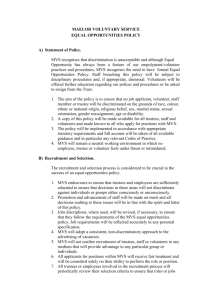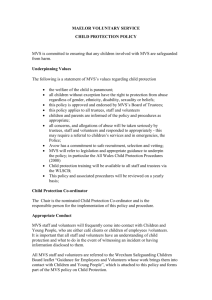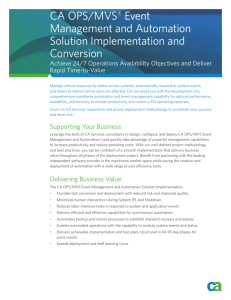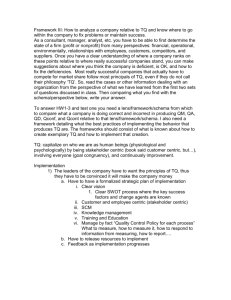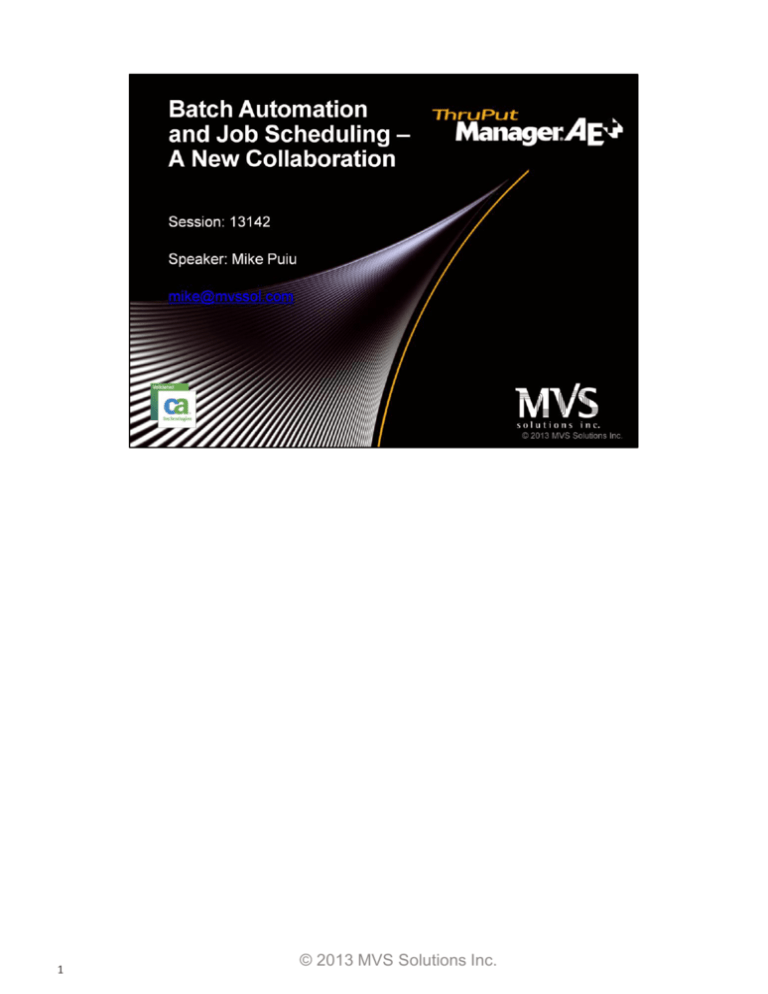
1
© 2013 MVS Solutions Inc.
2
—
ThruPut Manager SE has been around more than 25 years.
—
ThruPut Manager AE was released about 5 years ago and is managing the batch in many sites today.
—
Capacity management is a recent addition to ThruPut Manager AE and manages batch so as to allow the
installation to lower their soft cap and reduce their MSU usage and therefore the monthly fee to IBM
—
ThruPut Manager AE+ is the newest addition to the AE world. It communicates directly with CA 7 so that
jobs can be managed in context of their application, its importance and its due-out requirements.
Copyright © 2013 MVS Solutions Inc. All rights reserved.
ThruPut Manager
Essentials
4
Copyright © 2013 MVS Solutions Inc. All rights reserved.
5
© 2013 MVS Solutions Inc.
6
© 2013 MVS Solutions Inc.
7
© 2013 MVS Solutions Inc.
8
© 2013 MVS Solutions Inc.
9
© 2013 MVS Solutions Inc.
— 40 years ago an operator would run 50 – 60 jobs per night and know every one. That was
becoming impossible 25 years ago when the workload might be a few hundred to 2000
jobs. It is impossible today, when many installations run 20,000 to 100,000 jobs per day
through their scheduler.
— CA7 is itself an application, outside of z/OS and JES2 ,and has little or no influence on the
processing once a job is submitted
— PCS provides the link between CA7 and the z/OS world so that the entire schedule is
automated from schedule generation through to the end of the production cycle.
10
Copyright © 2013 MVS Solutions Inc. All rights reserved.
— This presentation is based on a small and simple CA7 database used for demos to illustrate
what PCS is doing.
— Slack time is an important concept in PCS and is recalculated continually for each path as
jobs end.
11
Copyright © 2013 MVS Solutions Inc. All rights reserved.
— This is one example of a simple application, with 1 tree and 2 paths.
— This application has three jobs that require exclusive use of the same dataset, leading to
contention situations.
12
Copyright © 2013 MVS Solutions Inc. All rights reserved.
— Of course there are setup tasks to be done for PCS. The first time only that PCS comes up,
it asks CA7 for the list of system names and then the list of jobs in each system, which it
uses to populate its Application Management Database or AMD
—
If necessary you can refresh the list of applications
— In the AMD dialog you can set due-out times and Production Importance (PI) for any
application
— As jobs are run, PCS captures experience data at the step level, including the elapsed time,
CPU usage, and number of tape drives actually used (including dynamic allocation)
— On a daily – or production cycle – basis, you run the batch job to capture the schedule data
for that period.
— That data is combined with the AMD data and our experience data to build a “Battle Plan”,
in which every application, tree and path in the schedule is calculated for its expected
runtime and its ability to meet the due-out time
13
Copyright © 2013 MVS Solutions Inc. All rights reserved.
— PCS manages selection priority based on the “rerun factor” (how much time is there to
rerun this job/path/tree in the event of a problem, expressed as a number, with 1 meaning
the job/path/tree could be rerun once), the slack time and the Production Importance
− Note slack time and rerun factor are dynamically recalculated as each job completes or
fails to start when expected
— Jobs are prepared to run while in the queue so that they can run immediately and without
delays once selected
— Tape drives are dynamically managed based on the needs of the job and the real
availability of drives
— Dataset contention is dynamically managed when a job is selected. A job may be held back
if its datasets are not available, rather than letting it occupy an initiator. Jobs held back are
released based on Importance
— The WLM Service Class is assigned as the job goes into execution, from a set that is
dedicated to ThruPut Manager
14
Copyright © 2013 MVS Solutions Inc. All rights reserved.
— This is the ‘dashboard’, the panel that gives a quick overview of your current status, and is
always the place to start
— Note the term ‘Job Instance’. This refers to a combination of the jobname and schedule id,
as in IAP2001_001
— Note also the term ‘Culprit’. This refers to jobs that are the cause of other jobs being late
— The panel shows how many applications, trees, paths, and job instances are late, are
calculated as will be late and were late
— It shows the total number of entities in the schedule, how many are done and how many
are still to be run
— It also shows the number of ‘Adhoc’ jobs. These are jobs submitted by CA 7, probably as a
result of being DEMANDed in, that were not in the schedule. These jobs do not have a
slack time and do not belong to a path or tree, since there is no information to identify
where they fit. However they do have a system name so do belong to an application and
will be managed with the importance of that application
15
Copyright © 2013 MVS Solutions Inc. All rights reserved.
— One of the choices is to view the schedule by application
— From this panel you can drill down to see the trees, paths and job instances in the
application and their status
16
Copyright © 2013 MVS Solutions Inc. All rights reserved.
— You can also view by Job Instance, as in this panel
— This is the left view of a wide panel (I use 132 for my width under ISPF)
— The panel contains a lot of information from PCS, CA 7, and z/OS . It provides the ability to
get more information from CA 7, through use of its commands, and from ThruPut Manager
through use of the I (Info) command
— Any non-dialog CA 7 command, such as LQ, LJOB, LRLOG, can be issued on the command
line prefixed by forward slash-blank (‘/ ‘)
17
Copyright © 2013 MVS Solutions Inc. All rights reserved.
— This is the same panel scrolled to the right. Notice the Job Instance id does not scroll
— The fields on the Job Instance panel are explained in the next few slides
18
Copyright © 2013 MVS Solutions Inc. All rights reserved.
19
Copyright © 2013 MVS Solutions Inc. All rights reserved.
— If the job is in execution, the Details column shows on which LPAR and in which step
— It also shows when a job has been cancelled or skipped in CA 7 and if its triggering job was
cancelled or skipped
20
Copyright © 2013 MVS Solutions Inc. All rights reserved
— This is the status according to CA 7
21
Copyright © 2013 MVS Solutions Inc. All rights reserved.
22
Copyright © 2013 MVS Solutions Inc. All rights reserved
— Acceptable Time is the time a Job Instance is expected to be completed by, after which it
will be considered to be late.
23
Copyright © 2013 MVS Solutions Inc. All rights reserved.
— Let’s look more closely at this panel.
— This job shows that it failed with a System abend, S106. An operator should know
immediately that this is something that requires technical support or programming to
resolve, and would therefore initiate a problem ticket and make a call
24
Copyright © 2013 MVS Solutions Inc. All rights reserved
— Here’s another job with an interesting status.
— It’s executing but is late – note the negative values for rerun factor and slack time
— It also shows that there are 11 jobs waiting on this and, by the C under Progress, that it is
considered a culprit
— To find out what is happening we put a ‘G’ for proGress, on the line.
25
Copyright © 2013 MVS Solutions Inc. All rights reserved
— The Culprit Details panel shows us in this case that the job has been executing for longer
than expected
— There are four commands that are often useful at this point, although not in this case, that
can be invoked by choosing 1, 2, 3 or 4.
— Even though it’s not really helpful in this situation let’s try 1 to illustrate what happens
26
Copyright © 2013 MVS Solutions Inc. All rights reserved
— Here is the result of a LQ command issued from the previous panel
— The results are displayed in a Browse window, meaning that it is scrollable up and down –
very useful for LJOB,LIST=ALL,…
27
Copyright © 2013 MVS Solutions Inc. All rights reserved
— Back on the Job Instance display, let’s find out how this job usually runs
— By placing an X on the line command area we can see the experience data for this job and
schedule id combination and determine how excessive its current run time is
28
Copyright © 2013 MVS Solutions Inc. All rights reserved
— The experience data shows that although the job usually runs for around 15 minutes it has
recently run as long as 20 minutes, so perhaps 22 minutes is not yet something to worry
about
— By the way, this experience data is what PCS uses to calculate the expected path lengths
29
Copyright © 2013 MVS Solutions Inc. All rights reserved
— So what would a good operator do? Not much for now
— Depending on how important and time-critical this job is, the operator will probably leave
it to run for another 5 or 10 minutes before calling anyone
— However, if that call is necessary operations can report the usual runtime, this runtime,
and the step the job is in
30
Copyright © 2013 MVS Solutions Inc. All rights reserved
— There is one more job of particular interest on this job instance panel, job IBK2001
— This job shows as Ready and Awaiting Execution
— Why is it not running? It’s clearly not a CA 7 situation so the cause is somewhere in the
world of z/OS, JES2 and ThruPut Manager. There could be a number of reasons so let’s find
out by using the I (Info) command
31
Copyright © 2013 MVS Solutions Inc. All rights reserved
— Info pops up a window giving you the status as understood by ThruPut Manager.
— It says ‘The Job was not selected because it was held by ThruPut Manager’. Why would
that be?
— In the top line of that pop-up it shows SLM in green and DC in red.
— SLM stands for Service Level Manager, the automation engine that, under the covers, is
getting the jobs selected and run according to the directions of PCS. Since it’s green it is
not the reason the job is held back
— DC stands for Dataset Contention and is the reason for the Hold
— To find out more, put the cursor on DC and hit Enter
32
Copyright © 2013 MVS Solutions Inc. All rights reserved
— Another pop-up appears with Dataset Contention information
— It shows that the job is waiting for one dataset, RSI01.GDEMO.HOLDDSN, and needs it
exclusive (DISP=OLD or DISP=MOD)
— The next thing to find out is who or what is holding this dataset. Put the cursor on the
dataset and hit Enter
33
Copyright © 2013 MVS Solutions Inc. All rights reserved
— And here’s the answer. The dataset in this case is in use by another batch job, IBK1001,
which also has it exclusive
34
Copyright © 2013 MVS Solutions Inc. All rights reserved
— So what would a good operator do about this job? Nothing, because ThruPut Manager is
already doing what needs to be done if it is possible
— In this case the operator – and ThruPut Manager - must simply wait until the holding job
releases the dataset
— If the dataset had been held by a TSO user the userid would have been shown
— The TSO user would have received nagging messages stating that the dataset was required
by job IBK2001
— If the job was importance level 1 or 2, and the user did not have the dataset open for
output or update, the user would have been warned that the dataset would be taken away.
If after that the dataset was not freed it would be removed from the TSO session, a
technique known as repossession
— Dataset fencing is a feature of ThruPut Manager and PCS intended to prevent a TSO user or
a job outside of the schedule from enqueueing a critical dataset and causing this situation
unnecessarily
35
Copyright © 2013 MVS Solutions Inc. All rights reserved
— Because of its connection to CA 7, PCS knows each job in the context of its application,
tree and path and can calculate when it needs to complete and therefore when it needs to
start
— It adds some padding – a Target time allowing for a rerun if possible – as well as the
Acceptable time, and tells SLM the selection priority, the Production Importance and
whether the job is late or on the most urgent path for the application
— SLM uses that information to manage the job in its PCS queue, move it as quickly as need
be to meet its selection goal, prioritize the preparation and set the Service Class
— SLM is cognizant of soft capping and, with its capacity management capability, will slow
down selection of batch according to your directions. For example, you might stop
selecting your lowest importance batch when at 90% of your desired cap, stop selecting
the next level at 92% and so on
36
Copyright © 2013 MVS Solutions Inc. All rights reserved
— The SDSF DA panel shows the current Service Class in use by each executing job.
— This display shows that job IBK3002, a job from the same application and with the same
Production importance, is running in a Service Class called SLMHIGH, whereas our late job,
IBK1001, is running in Service Class SLMVHI (very high), as set by SLM
37
Copyright © 2013 MVS Solutions Inc. All rights reserved.
— PCS provides intelligent use of your system resources to meet the goals of your schedule
— It automatically adjusts the selection priority and Service Class for a job based on progress
of the schedule
— It removes your dependence on the knowledge of a very few veteran operators
— PCS has been part of an Early Availability program and is now generally available.
— One large company has been managing all their production under PCS control since July of
2011
— Another managed all the work in their development CA 7 and used Monitor mode (all the
panels, messages, alerts and so on but without actually managing the work) in production
during the BETA phase but now are using PCS to manage almost all their production as
well.
38
Copyright © 2013 MVS Solutions Inc. All rights reserved.

